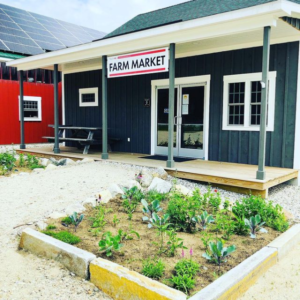Local Farm Ups Their Environmental Game and Savings With Solar Power
2021 marks the first year of Replenova Farms solar array installation, and it is exceeding all expectations.
Gary Goodrich’s farm in Durham, Maine, grows organic vegetables using sustainability in all of its practices and has been doing so for five years.
The 17-acre MOFGA certified vegetable farm also hosts a barn, a farm market with two commercial kitchens, and five high tunnel greenhouses. The farm market is heated and requires a lot of electricity to power its hot water system, refrigeration (three refrigerators and freezer), a walk-in cooler, and lights. All appliances are electric, including two ovens and induction burners used daily to provide the store’s breakfast and lunch items and baked goods.
Rather than using oil or gas energy, the farm chose to harness solar power for all of its utilities.
“Solar has been a great saver for us,” said Gary Goodrich, owner of Replenova Farm, who is among a growing number of farmers that are generating solar power to meet their needs.
“We are striving to sustain the land, water, and air resources while feeding people locally through our farm market. This also includes wholesale customers, vegetable donations to the Good Shepherd Food Bank, and directly to some of their food providers,” said Goodrich.

The solar power enabled the farm to produce all of its energy requirements in 2020 with sufficient capacity to add more refrigeration and heating in the future, allowing them to be truly sustainable for all of the farm’s energy needs.
The system was installed by Maine Solar Solutions in late 2019. Maine Solar Solutions, a locally based solar installation company, took various factors into account when designing the system for Goodrich to find the perfect individual solar solution for the farm.
The 59 panels supplied 31,600 kWh of energy in 2020, providing enough power to run the entire farm’s electricity over the course of one year. During sunny months, the farm banks excess energy – storing it for the colder, cloudier months when the panels will not gather as much energy.
The system has also positively impacted the environment, offsetting 48,938 pounds of carbon emissions in its first year – equivalent to planting 370 trees.
“We are very pleased with the system’s performance,” said Goodrich, “It really has exceeded our expectations.”
Goodrich also received a grant from the U.S. Department of Agriculture’s “Rural Energy for America” program for part of the project’s total cost.
“Maine Solar Solutions assisted me with the entire application process as well. As a farmer, we are swamped, and they make the process easy. Not sure we would have applied without them,” said Goodrich.
The Rural Energy for America program commonly referred to as REAP, provides grant or loan assistance for businesses in rural areas, providing up to 25% of the total project cost for renewable energy installation or energy efficiency improvement.
“Gary is leading by example, showing our residents the importance of renewable energy, which will help the environment while keeping their business costs low,” said Sam Zuckerman, owner of Maine Solar Solutions. “We were happy to be able to assist them in this project and help them win the REAP grant.”
Another bonus to solar Goodrich wanted to share is that it is easy and virtually maintenance-free.
“These systems are pretty well maintenance-free,” Goodrich said. “Inverters monitor our system, and we have apps on our phones and computers where we can actually look at the amount of electricity that is being produced on an hourly, daily, and yearly basis.”
Goodrich said it was estimated he would use 30,569 kWh per year at the farm, making for costly electric bills. For reference, most homes use about 7,500 kWh per year. Goodrich said the panels would pay for themselves in 9-10 years, and after that, he will enjoy the fixed Central Maine Power Solar Fee of $17 to run his farm’s electricity for the next 25+ years.
Goodrich said it makes sense for farmers and local businesses to look at all options to help save money, and solar can be a viable answer for many.
With the added savings, Goodrich cannot only upgrade his farm but give back even more to the community. This year they will be stepping up their contribution to above 2000 lbs of organic vegetables.
“If we can do projects like this to not only save money but help our environment and give back to our communities, just by taking advantage of something as abundant as the sun, then it’s worth looking into,” Goodrich said.

